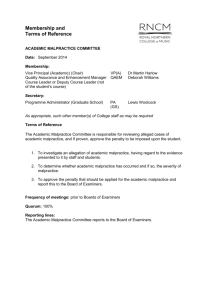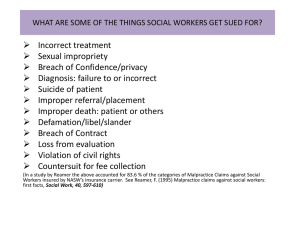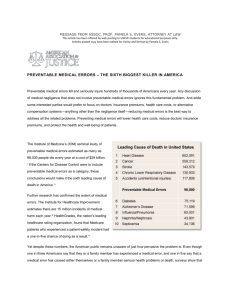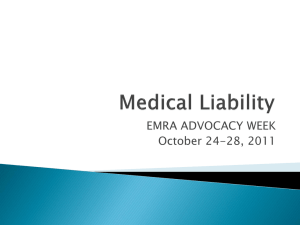Econ Medical Malpractice
advertisement
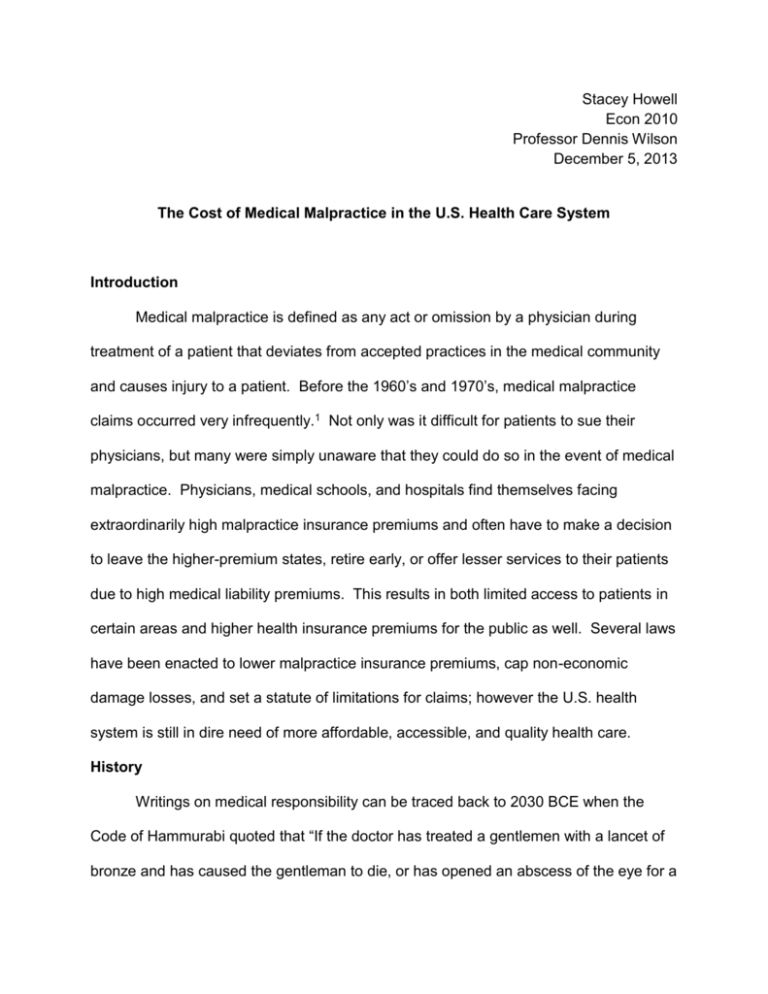
Stacey Howell Econ 2010 Professor Dennis Wilson December 5, 2013 The Cost of Medical Malpractice in the U.S. Health Care System Introduction Medical malpractice is defined as any act or omission by a physician during treatment of a patient that deviates from accepted practices in the medical community and causes injury to a patient. Before the 1960’s and 1970’s, medical malpractice claims occurred very infrequently.1 Not only was it difficult for patients to sue their physicians, but many were simply unaware that they could do so in the event of medical malpractice. Physicians, medical schools, and hospitals find themselves facing extraordinarily high malpractice insurance premiums and often have to make a decision to leave the higher-premium states, retire early, or offer lesser services to their patients due to high medical liability premiums. This results in both limited access to patients in certain areas and higher health insurance premiums for the public as well. Several laws have been enacted to lower malpractice insurance premiums, cap non-economic damage losses, and set a statute of limitations for claims; however the U.S. health system is still in dire need of more affordable, accessible, and quality health care. History Writings on medical responsibility can be traced back to 2030 BCE when the Code of Hammurabi quoted that “If the doctor has treated a gentlemen with a lancet of bronze and has caused the gentleman to die, or has opened an abscess of the eye for a gentleman with a bronze lancet, and has caused the loss of the gentleman’s eye, one shall cut off his hands.”2 It wasn’t until the mid-1800’s when the United States began to form legalities regarding principles and opinions of medical education and practice, standards of care, and errors in judgment. Most medical malpractice claims during this time stemmed from treatment of amputations, fractures, and dislocations, and physicians faced charges up to $3,000 which was typically about six times their annual income. These charges were paid directly by the physician, since medical malpractice insurance did not become available until the 1890’s.1 Before the 1960’s,legal claims for medical malpractice were very infrequent and often did not have a large impact on the practice of medicine. Since the 1960’s and 1970’s medical malpractice claims are much more prevalent – in fact, 75% of low-risk specialty physicians will face a medical malpractice claim in their career and it is almost certain (99%) that a high-risk specialist will face a medical malpractice claim in his or her career.3 Medical Malpractice Insurance Medical malpractice insurance will cover a physician or hospital in the event that a patient claims a liability for substandard care. Most states require physicians and hospitals to carry medical malpractice insurance; however if a physician or hospital elects not to carry the insurance, they will most likely forfeit any contracts with managed care organizations. Even more importantly, the physician or hospital will be responsible for paying out-of-pocket for costs resulting in a malpractice litigation. Malpractice insurance costs for physicians and hospitals have continued to increase dramatically since the 1970’s. In the last decade schools of medicine and hospitals have seen their liability premium costs increase from six to ten times – from thousands of dollars a year to millions. In some states, private physicians and specialists have seen their premiums triple or quadruple in just a few years. 4 Medical malpractice insurance premiums vary among different specialties, but it is clear that physicians are paying top dollar for peace of mind. For example, obstetricians/gynecologists faced a yearly premium average of $206,913 in 2011. General surgeons reached a yearly premium average of $128,542 in 2011. 5 The figure on the right shows total expenditures on medical malpractice insurance premiums along with payments made for malpractice claims. Influence on the U.S. Health care System The growth in medical malpractice insurance premiums has a great effect on health care in the United States. The rising cost for physicians may drive them to another medical specialty or perhaps another location, making the access of health care to patients in certain areas limited. For example, in Massachusetts, nearly half of all physicians altered or limited their services because of risk of liability. Also, one in twelve obstetricians who have reported changes in their practice due to risk of malpractice liabilities have stopped delivering babies altogether.6 Since physicians and hospitals are now using "defensive medicine" (performing more tests and procedures than necessary in order to reduce exposure to lawsuits) more often, this liability pressure increases U.S. health care system costs between $84 and $151 billion per year.6 Both rising malpractice premiums and defensive medicine practices may contribute to the increase in health insurance premiums for the public. 7 Health insurance companies are simply forced to raise premium costs in order to keep their business viable. Medical Malpractice Reforms In the United States, medical malpractice law has traditionally been under the authority of the individual states and not the federal government. To win monetary compensation for injury related to medical negligence, a patient needs to prove that insufficient medical care resulted in an injury.7 The malpractice laws are generally based on “customary practice” -- that is, a doctor can be considered guilty of malpractice if he or she fails to follow customary practices. Seemingly this could cause health care costs to decline if all states’ malpractice laws protected doctors who followed national or customary standards of practice. This resulted in the Center for American Progress proposing a “safe harbor” to protect physicians from liability if they used qualified health information technology and evidence-based medical practice guidelines.8 As previously mentioned, medical malpractice insurance premiums have skyrocketed – they increased 1,029 percent between 1976 and 2007.6 This in turn forced many physicians to close their doors due to the inability to afford the insurance and burdened the public with limited access to affordable health care. The Medical Injury Compensation Reform Act (MICRA) of 1975 was first enacted in California to lower medical liability premiums. The reform also limits attorney contingency fees in a malpractice litigation, only allows up to $250,000 to be awarded for non-economic damages, and requires advanced notice of a claim within a set statute of limitations. MICRA has increased access to health care by allowing physicians and hospitals to keep their practices open due to more affordable malpractice insurance, saved the health care system several billion dollars, and has been an influence on many other states to enact a version of MICRA as well.9 Similar to MICRA, Texas enacted House Bill 4 and Proposition 12 in 2003 to cap lawsuit awards to patients for non-economic damages in the case of a malpractice litigation. Health care expenditures reduced greatly and allowed more physicians and hospitals to stay in business due to lower malpractice insurance premiums. The number of new doctors licensed in Texas increased by almost 58% between 2001 and 2012 and the Texas physician workforce has outpaced population growth every year since 2007.8 Studies show that caps on non-economic damages on medical liability losses have proven effective in lowering the growth of malpractice losses as well as a lower growth rate in insurance premiums. Cap reforms have also shown a positive effect on the number of physicians per capita in a state.9 The American Medical Association (AMA) is urging Congress to pass a reform at a federal level to put a $250,000 cap on non-economic damages, provide funding for health courts, and providing a “safe harbor” for all physicians using an evidence-based practice of medicine.6 Conclusion Medical malpractice is a challenging aspect (on top of many others) in the U.S. health care system. It not only affects physicians, but insurance companies and patients alike. Although legalities have been established to form a basis for medical malpractice litigations, malpractice claims have risen greatly since the 1960’s and 1970’s. The extremely high costs of medical malpractice insurance push physicians out of areas with high-cost premiums and into areas with low-cost premiums. The expensive premiums also cause physicians to get rid of higher-risk services altogether; these aspects are a huge detriment to the access of healthcare to patients in certain areas. Reforms have been established to decrease medical malpractice insurance costs; and although they have been somewhat effective, it is only a scratch on the surface. Reforms establishing caps for non-economic damages to plaintiffs have also been effective in decreasing the growth rate of malpractice losses along with lowering malpractice insurance premiums for physicians. There is hope for the future that malpractice litigations will become uncommon, malpractice insurance premiums will be low, and that U.S. health care will reach a stable point between high quality, easy access, and affordable cost. References 1. Frese, Richard C., and Patrick J. Kitchen. "Perspectives On Medical Malpractice SelfInsurance Financial Reporting." Healthcare Financial Management: 50-54. 2012. Web. 23 Nov 2013 2. Bal, B. Sonny. "An Introduction to Medical Malpractice in the United States." NCBI. 26 Nov 2008. Web. 23 Nov 2013. 3. Jena, Anupam, Seth Seabury, and et al. "Malpractice Risk According to Physician Specialty." The New England Journal of Medicine. 28 Aug 2011. Web. 25 Nov 2013. <http://www.nejm.org/doi/full/10.1056/NEJMsa1012370> 4. Sultz, Harry, and Kristina Young. Health Care USA. 7th Edition. Jones & Bartlett Learning, 2011. 176. Print. 5. Lewis Jr., Morgan. "Medical Malpractice Costs Continue to Climb." Medical Economics. N.p., 11 Jan 2012. Web. 25 Nov 2013. <http://medicaleconomics.modernmedicine.com/medicaleconomics/news/clinical/practice-management/medical-malpractice-costscontinue-climb> 6. American Medical Association, . "The Case for Medical Liability Reform." American Medical Association. 2011. Web. 23 Nov 2013. <http://www.amaassn.org/ama1/pub/upload/mm/-1/case-for-mlr> 7. NBER, "Do Medical Malpractice Costs Affect the Delivery of Health Care?." The National Bureau of Economic Research. 2012. Web. 23 Nov 2013. <http://www.nber.org/bah/fall04/w10709.html> 8. Emanuel, Zeke, Topher Spiro, and Maura Calsyn. "Reducing the Cost of Defensive Medicine." Center for American Progress. 11 Jun 2013. Web. 23 Nov 2013. <http://www.americanprogress.org/issues/healthcare/report/2013/06/11/65941/re ducing-the-cost-of-defensive-medicine/> 9. CAPP, "History of MICRA." Californians Allied for Patient Protection. 2012. Web. 23 Nov 2013. <http://www.micra.org/micra/history-of-micra.html> 10. Burkle, Christopher. "Medical Malpractice: Can We Rescue a Decaying System?." NCBI. Apr 2011. Web. 25 Nov 2013. <http://www.ncbi.nlm.nih.gov/pmc/articles/PMC3068892/> 11. Texas Medical Association, "Proposition 12 Produces Healthy Benefits." Texas Medical Association. 28 Aug 2013. Web. 23 Nov 2013. <http://www.texmed.org/Template.aspx?id=5238> 12. Kane, Carol, and David Emmons. "Policy Research Perspectives." American Medical Association. Dec 2005. Web. 23 Nov 2013. <http://www.amaassn.org/ama1/pub/upload/mm/363/prp200502caps.pdf>

